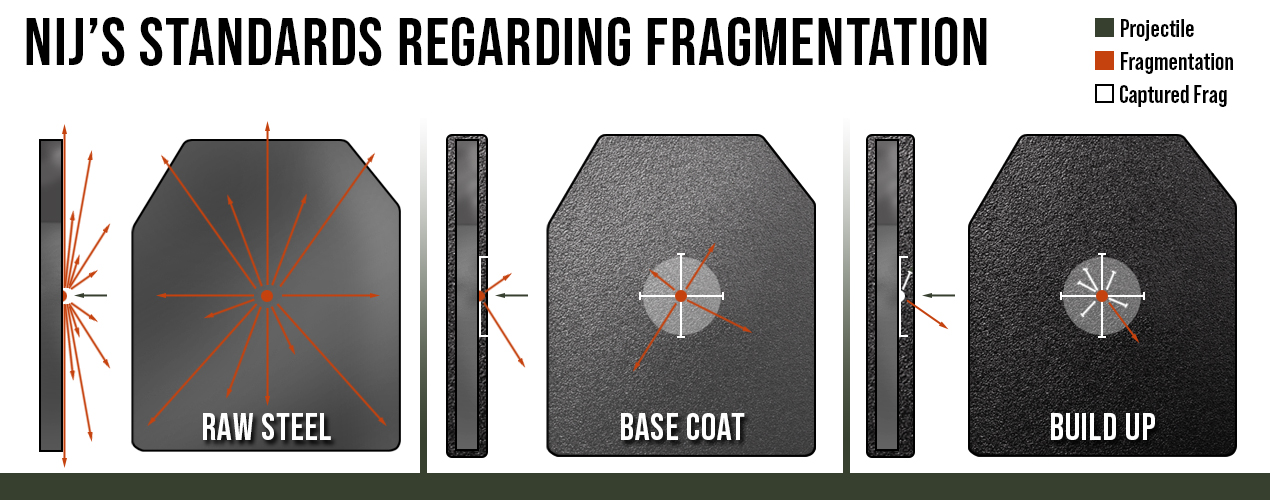The NIJ's Standards Regarding Fragmentation
When you’re out shooting with a steel target, you might notice that hits on the steel cause dirt to fly up at the target’s feet; a common reminder that there’s fragmentation every time a bullet impacts something.

On our Body Armor 101 page, we briefly mention this fact as we explore the meaning of fragmentation and its effects. Today, we’ll be exploring that topic in more detail to see what the NIJ has to say about fragmentation in its current standard.
First, though, a quick review: Fragmentation is a broad term that can be used to refer to any fragments flying off a bullet’s impact on a piece of armor. However, for greater specificity, the term “fragmentation” is reserved for bullet fragments that come from the front of the plate after impact, while armor fragments are referred to as “spalling” and come from the back of the plate.
While the most important part of a bullet’s impact is its penetrating ability, the fragmentation that comes after a successful stop is also a source of some concern; comparisons between different materials should be made in that regard in addition to just stopping power. With that said, the NIJ makes some mention of fragmentation in its 0101.06 standards, but not in the way we’re discussing here. In fact, only the word “fragments” is used, and it’s just in the definitions for “Penetration” and “Perforation.” The manual states, for example:
“Perforation: Any impact that creates a hole passing through the armor. This may be evidenced by any of the following: (1) the presence of the projectile, a projectile fragment, or an armor fragment in the clay backing material; (2) a hole that passes through the armor and/or backing material; or (3) any portion of the bullet being visible from the body side of the armor panel. The term perforation is synonymous with the term complete penetration.“
In this section, fragments of the bullet that punch a hole through the plate are, for the sake of clarity, defined as a complete penetration or perforation. That’s a form of fragmentation that is already mitigated if your plate successfully stops a bullet. But there’s nothing about the fragmentation that occurs even when the bullet is stopped; the fragmentation that hits the dirt at the shooting range, or the fragmentation that could hit the bottom of your chin or your neck in a firefight.
That’s because this is another instance where the NIJ has decided not to test plates for a specific ability (in this case, frag and spalling mitigation), but rather limit its standards to a smaller set of concerns; the NIJ is focused mostly on the raw ability of a plate to stop a bullet in both “like new” and “conditioned” situations. It’s also worth noting that fragmentation would be very difficult to test in a standardized fashion, unlike penetration/perforation tests.
However, we do have some helpful information on comparing different plate performance in this regard:
- Steel without coating is not going to protect you from fragmentation and spalling, since it intentionally will destroy the bullet on impact, causing some of it to stick in the front of the plate and the rest of it to fly off. However, all our Steel options come with our unique FragLock™ coating to mitigate this very issue. The Build-Up Coat is especially effective at mitigating fragmentation.
- Ceramic, while not as intense as steel, also creates a considerable amount of fragmentation and spalling when hit. For this reason, our FragLock™ coating is also applied to our Level IV C2 Plate, although some manufacturers forgo any kind of coating on their competing designs.
- Polyethylene is the most capable of natural fragmentation and spalling mitigation due to its technique of “swallowing” bullets that impact it: When a bullet hits a PE plate, the bullet’s spin makes the front of the plate soften (from the heat), at which point the bullet is captured by the plate and then rehardens. For this reason, Polyethylene plates do not normally receive a significant coating.
Here is a compilation of tests conducted by Armored Republic to demonstrate different armor and rounds’ fragmentation and spalling effect.
So keep this information in mind when making your next plate purchase; Level III Steel may perform very differently from a Level III PE in this regard, especially when you consider the various coating options, and that difference may be what finalizes your plate choice. After all, the dirt right below a steel target is quite unenviable.
